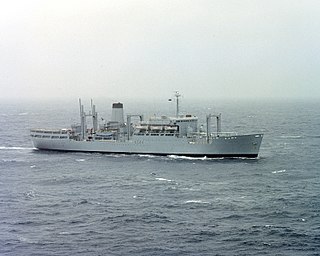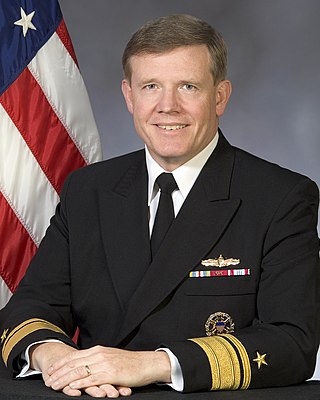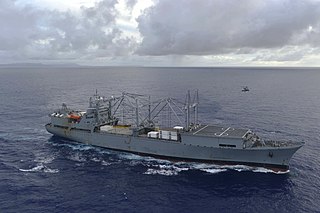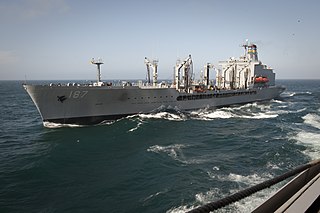The United States Armed Forces are the military forces of the United States. The armed forces consists of six service branches: the Army, Marine Corps, Navy, Air Force, Space Force, and Coast Guard. The president of the United States is the commander-in-chief of the armed forces and forms military policy with the Department of Defense (DoD) and Department of Homeland Security (DHS), both federal executive departments, acting as the principal organs by which military policy is carried out. All six armed services are among the eight uniformed services of the United States.

The United States Merchant Marine are United States civilian mariners and U.S. civilian and federally owned merchant vessels. Both the civilian mariners and the merchant vessels are managed by a combination of the government and private sectors, and engage in commerce or transportation of goods and services in and out of the navigable waters of the United States. The Merchant Marine primarily transports domestic and international cargo and passengers during peacetime, and operate and maintain deep-sea merchant ships, tugboats, towboats, ferries, dredges, excursion vessels, charter boats and other waterborne craft on the oceans, the Great Lakes, rivers, canals, harbors, and other waterways. In times of war, the Merchant Marine can be an auxiliary to the United States Navy, and can be called upon to deliver military personnel and materiel for the military.

The Lewis and Clark class of dry cargo ship is a class of 14 underway replenishment vessels operated by the United States Navy's Military Sealift Command. The ships in the class are named after famous American explorers and pioneers.

RFA Stromness (A344) was a fleet stores ship which served the Royal Fleet Auxiliary until sold to the U.S. Navy's Military Sealift Command in 1983. While in the service of British forces, it saw service in the Falklands War. After the sale to the United States, it was renamed USNS Saturn (T-AFS-10) and acted as a combat stores ship until it was deactivated in 2009; it was able to supply two other ships at once. In 2010, it was sunk in an exercise by the U.S. Carrier Strike Group Two off the coast of North Carolina.

Military Sealift Command (MSC) is an organization that controls the replenishment and military transport ships of the United States Navy. Military Sealift Command has the responsibility for providing sealift and ocean transportation for all US military services as well as for other government agencies. It first came into existence on 9 July 1949 when the Military Sea Transportation Service (MSTS) became solely responsible for the Department of Defense's ocean transport needs. The MSTS was renamed the Military Sealift Command in 1970.

HSV-2 Swift is a hybrid catamaran. She was privately owned and operated by Sealift Inc., and was originally built under the JHSV program as a proof of concept. As part of this program, she was directly leased for evaluation from her builders by the United States Navy Military Sealift Command from 2003 to 2013, primarily as a mine countermeasures and sea basing test platform. Later during her official naval career she was mostly used for fleet support and humanitarian partnership missions.

SS Flickertail State (T-ACS-5) is a crane ship in ready reserve for the United States Navy. She is stationed at Newport News, Virginia and is in ready reserve under the Military Sealift Command (MSC). The ship was named for the state of North Dakota, which is also known as the Flickertail State.

Rear Admiral Robert Dunham Reilly Jr. was a United States Navy Surface Warfare Flag Officer who retired from active duty in January 2010 after 34-plus years of military service. His last assignment was as the 24th commander of the U.S. Navy's Military Sealift Command (MSC).
The structure of the United States Navy consists of four main bodies: the Office of the Secretary of the Navy, the Office of the Chief of Naval Operations, the operating forces, and the Shore Establishment.

MV Capt. Steven L. Bennett (T-AK-4296) was a container ship and lead ship of her class. Originally named TNT Express, she was built by Samsung Heavy Industries in Koje, South Korea in 1984. She was named after United States Air Force Medal of Honor recipient Captain Steven L. Bennett. The ship was a Logistics Prepositioning Ship sponsored by the U.S. Air Force. The ship returned to commercial service after the MSC contract ended in October 2012.

SS Curtiss (T-AVB-4) is one of two Wright-class aviation logistics support ship converted for the Military Sealift Command by Todd Shipyards in 1987.

MV Transpacific, also known as Bonito, also known as Turcas II, also known as Nikolay Shalavin (2001) is an oil tanker under long-term charter to the United States Military Sealift Command (MSC). As part of MSC's Sealift Program, the Transpacific transports fuel for the U.S. Department of Defense. Small and having shallow-draft, the Transpacific is known as a T-1 equivalent tanker, and moves petroleum products intra-theater in between Japan, Korea and The Marshall Islands.

USNS Henry J. Kaiser (T-AO-187) is a United States Navy fleet replenishment oiler and the lead ship of her class. Her mission is to resupply U.S. Navy and allied ships at sea with fuel oil, jet fuel, lubricating oil, potable water, and dry and refrigerated goods, including food and mail.

USS Wahkiakum County (LST-1162), previously USS LST-1162, was a United States Navy landing ship tank (LST) in commission from 1953 to 1970, and which then saw non-commissioned Military Sealift Command service as USNS Wahkiakum County (T-LST-1162) from 1972 to 1973.

MV Kalia is a small double-hulled oil tanker managed by Adminros Shipmanagement Company, Ltd. and registered under the flag of Cyprus. The 109-meter-long ship has a nominal crew of 13 and can carry 30,000 barrels (4,770 m3) of oil. While known as the MV Montauk, the ship was owned by the American company Sealift Incorporated, and sailed under long-term charter to the United States Military Sealift Command where it transported oil for the U.S. Department of Defense.

USNS John McDonnell (T-AGS-51) was a hydrographic survey ship operated by the Military Sealift Command (MSC) with a contract crew for the Naval Oceanographic Office which assigned a military and civilian hydrographic detachment to conduct coastal surveys. The ship and its sister, USNS Littlehales (T-AGS-52), were replacements for the coastal hydrographic survey vessels USNS Chauvenet (T-AGS-29) and USNS Harkness (T-AGS-32).
The Type C7 ship(Lancer Class) is a United States Maritime Administration (MARAD) designation for a cargo ship and the first US purpose-built container ship. The vessels were constructed in US shipyards and entered service starting in 1968. As US-built ships they were Jones Act qualified for shipments between US domestic ports. Under the Jones Act, domestic US maritime trade is restricted to US-built and flagged vessels of US owners and manned by predominantly US-citizen crews. The last active Lancer container-configured ship was scrapped in 2019. Lancers of the vehicle Roll-on/Roll-off (RO/RO) configuration remain held in the Ready Reserve Force, National Defense Reserve Fleet and the US Navy Military Sealift Command. All are steam powered.

USNS Pecos (T-AO-197) is a Henry J. Kaiser-class underway replenishment oiler operated by the Military Sealift Command to support ships of the United States Navy, and the third such ship to be named after the Pecos River.

MV Cape Horn (T-AKR-5068) was originally built as a commercial ship in 1979 and sold to the Wilhelmsen Line with the name Barber Tonsberg. She has two sister ships: MV Cape Hudson and MV Cape Henry.

USNS Sgt. William R. Button (T-AK-3012),, is the fifth ship of the 2nd Lt. John P. Bobo-class cargo ship built in 1986. The ship is named after Sergeant William Robert Button, an American Marine who was awarded the Medal of Honor during United States occupation of Haiti.

















